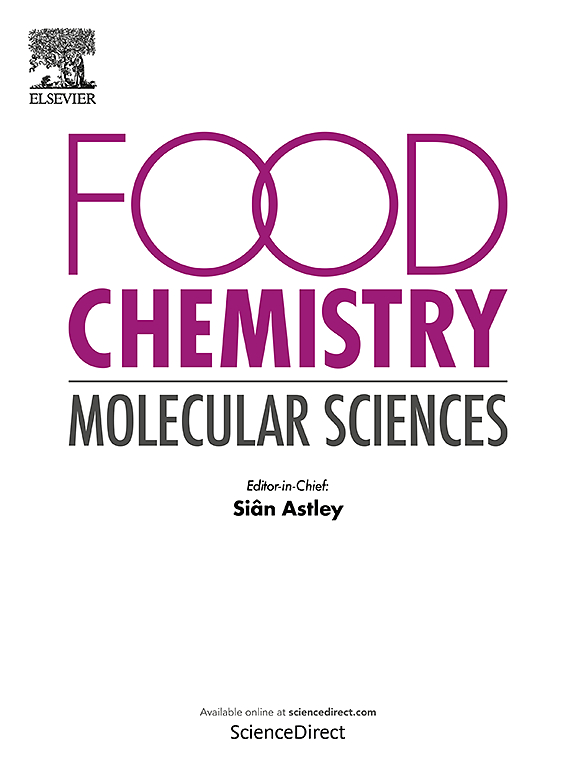Deciphering the metabolic patterns of cashew apple ripening process: A comprehensive non-targeted metabolomics analysis
IF 4.7
Q2 FOOD SCIENCE & TECHNOLOGY
引用次数: 0
Abstract
Metabolite changes during the ripening process of cashew apples are crucial for their quality development. A total of 2379 metabolites were isolated and identified from fresh cashew apples at four different ripening stages using UHPLC-MS. Metabolite set enrichment analysis (MSEA) revealed that the differential metabolites in CA2_vs_CA1, CA3_vs_CA2, and CA4_vs_CA3 comparisons were mainly enriched in amino acids and peptides, steroids, pyrimidines, and fatty acids and conjugates, etc. Volcano plot analysis identified 631, 384, and 392 upregulated metabolites, and 625, 923, and 392 downregulated metabolites in CA2_vs_CA1, CA3_vs_CA2, and CA4_vs_CA3 comparisons, respectively. KEGG pathway enrichment analysis demonstrated that these differential metabolites were primarily involved in aminoacyl-tRNA biosynthesis, purine metabolism, and glycine, etc. Notably, the differential metabolites in CA4_vs_CA3 showed the highest enrichment in d-glutamine and D-glutamate metabolism, as well as phenylalanine. The metabolic profile of cashew apples revealed stage-specific patterns during ripening, offering key insights for optimizing harvest, storage, and processing.
解读腰果苹果成熟过程的代谢模式:一项全面的非靶向代谢组学分析
腰果成熟过程中代谢物的变化对其品质发育至关重要。采用高效液相色谱-质谱法从4个不同成熟期的新鲜腰果中分离鉴定了2379种代谢物。代谢物集富集分析(MSEA)显示,CA2_vs_CA1、CA3_vs_CA2和CA4_vs_CA3的差异代谢物主要富集于氨基酸和多肽、类固醇、嘧啶、脂肪酸和偶联物等。火山图分析在CA2_vs_CA1、CA3_vs_CA2和CA4_vs_CA3比较中分别鉴定出631、384和392个上调代谢物,625、923和392个下调代谢物。KEGG通路富集分析表明,这些差异代谢物主要参与氨酰基trna生物合成、嘌呤代谢、甘氨酸等。值得注意的是,CA4_vs_CA3的差异代谢物在d-谷氨酰胺和d-谷氨酸代谢以及苯丙氨酸中富集程度最高。腰果苹果的代谢谱揭示了成熟过程中特定阶段的模式,为优化收获、储存和加工提供了关键见解。
本文章由计算机程序翻译,如有差异,请以英文原文为准。
求助全文
约1分钟内获得全文
求助全文
来源期刊

Food Chemistry Molecular Sciences
Agricultural and Biological Sciences-Food Science
CiteScore
6.00
自引率
0.00%
发文量
83
审稿时长
82 days
期刊介绍:
Food Chemistry: Molecular Sciences is one of three companion journals to the highly respected Food Chemistry.
Food Chemistry: Molecular Sciences is an open access journal publishing research advancing the theory and practice of molecular sciences of foods.
The types of articles considered are original research articles, analytical methods, comprehensive reviews and commentaries.
Topics include:
Molecular sciences relating to major and minor components of food (nutrients and bioactives) and their physiological, sensory, flavour, and microbiological aspects; data must be sufficient to demonstrate relevance to foods and as consumed by humans
Changes in molecular composition or structure in foods occurring or induced during growth, distribution and processing (industrial or domestic) or as a result of human metabolism
Quality, safety, authenticity and traceability of foods and packaging materials
Valorisation of food waste arising from processing and exploitation of by-products
Molecular sciences of additives, contaminants including agro-chemicals, together with their metabolism, food fate and benefit: risk to human health
Novel analytical and computational (bioinformatics) methods related to foods as consumed, nutrients and bioactives, sensory, metabolic fate, and origins of foods. Articles must be concerned with new or novel methods or novel uses and must be applied to real-world samples to demonstrate robustness. Those dealing with significant improvements to existing methods or foods and commodities from different regions, and re-use of existing data will be considered, provided authors can establish sufficient originality.
 求助内容:
求助内容: 应助结果提醒方式:
应助结果提醒方式:


